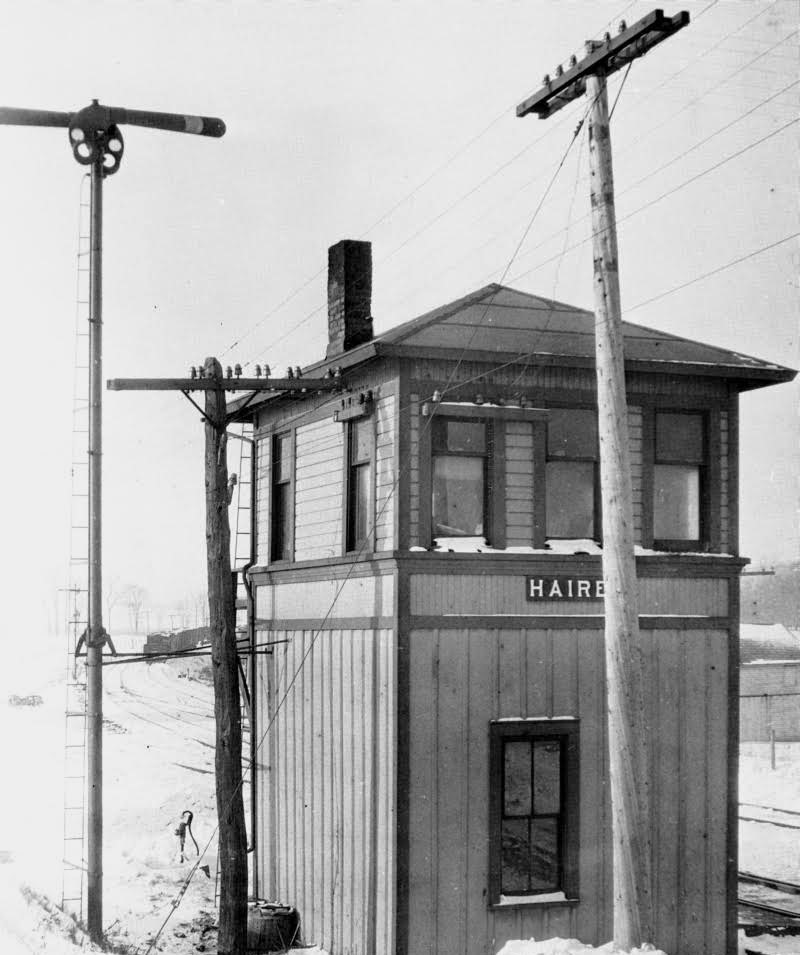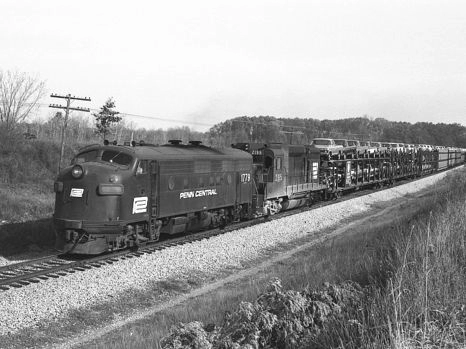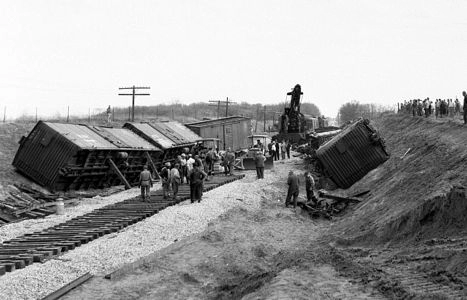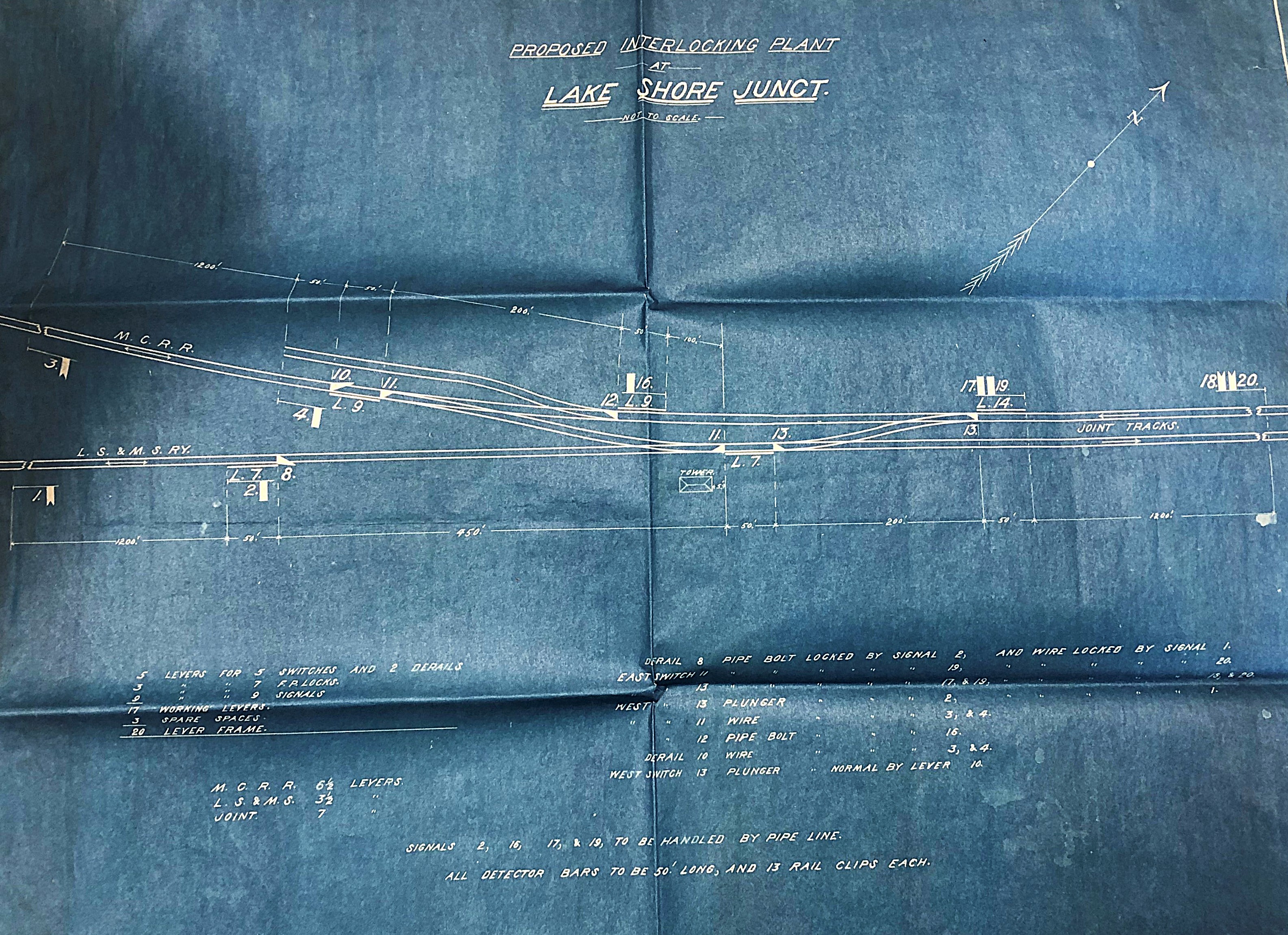- Details
- Hits: 5457
Interlocking: Haires, MI



 Haires, in Jackson County, was a crossing (and later a junction point) of the Fort Wayne, Jackson & Saginaw railroad and the Michigan Air Line railroad about five miles southwest of downtown Jackson. It was also known as Fort Wayne Junction (on the Air Line) in early times but Fort Wayne Junction was also a named location in Hillsdale County on the FWJ&S line.
Haires, in Jackson County, was a crossing (and later a junction point) of the Fort Wayne, Jackson & Saginaw railroad and the Michigan Air Line railroad about five miles southwest of downtown Jackson. It was also known as Fort Wayne Junction (on the Air Line) in early times but Fort Wayne Junction was also a named location in Hillsdale County on the FWJ&S line.
Photo Info: Top, the interlocking tower at Haires in the early 1900's. The Michigan Air Line goes off to the right behind the tower. The Fort Wayne & Jackson goes to the left with the tower in between. [Allen County Historical Society/Doug Leffler Collection]. 2nd photo, Penn Central 1779 (F unit) and 2195 (GP-30) lead westbound train DC-1 near Haires in 1975. Note the open bi-level auto rack cards in this consist. [Doug Leffler]. 3rd photo, a wreck on the NYC at Haires around 1957. [Cecil Homereding photo, Doug Leffler collection]. 4th image, a drawing of the interlocking in 1899.
Notes
Haires was a crossing of New York Central lines west of Jackson (the former Michigan Air Line to Three Rivers and Niles, and the former Fort Wayne & Jackson line to Jonesville and Fort Wayne). These two branch lines were independently built parallel between Haires and Jackson over a one year period around 1870. At Haires, the Fort Wayne branch would cross the Air Line, before diverging south. Though both lines would quickly come under the control of Vanderbilt interests, the Air Line was operated by the Michigan Central, while the Fort Wayne line was part of the Lake Shore (and later NYC) interests.
During early times, Haires was a staffed block station at the crossing. Within one year, two trains had a head on collision at the crossing. This was before the crossing was interlocked to prevent collisions. A westbound Air Line train approached the tower at speed and suddenly found a northbound FW&J train approaching also at speed, causing a collision. A tower and interlocker was installed about 1890.
The crossing later was converted to a junction instead of a crossing. The two tracks of the former lines were combined to serve as a double track line to Jackson.
It is said that the steam locomotive shops in Jackson used this double track to test locomotives which had been repaired in the shops.
Later, one of these tracks was downgraded to a siding or running track and later it was removed.
The FW&J was abandoned in the 1970’s, leaving only the Air Line branch. In the 1950's, centralized traffic control was installed on the "Air Line" from OD Tower (in Jackson) going west to Elkhart. The CTC was controlled by the dispatcher at Jackson.
Both branch lines have now been removed and the right-of-way is now a bike trail.
On 4/19/2024 Jesse Burkhardt writes: "The Fort Wayne route off the Elkhart line at Haires Junction was gone in the early 1960s, but there was still service from Hillsdale to Horton or Hanover from the south. I recall being in Hanover in 1960s and the tracks looked as if they still were in some kind of use. Someone there told me the train ran once every six weeks or so to bring some kind of drilling mud, or something like that, to a mining operation in the Hanover-Horton area. I also remember seeing an oval Yard Limits sign just south of what once had been Haires on the line to Fort Worth; it was mostly obscured by sumac bushes and the like. What an antique."
Time Line
1869. November. The Fort Wayne, Jackson & Saginaw is built through Haires from Jackson to Reading. It is completed in 1870 to Fort Wayne. [MRL]
1870. Summer. The Michigan Air Line Railroad built their line through Haires from Jackson Junction to milepost 17. It crossed the FWJ&S at this time. [MRL]
1870. The Michigan Air-Line Railroad company is building a track from Jackson to the Fort Wayne road (later called Haires) four miles south. It has been the intention to use the Fort Wayne track for the trains of both roads, but it was feared by the managers of the new road that the arrangement would cause a great deal of inconvenience. The new track will run parallel with and in close proximity to the one already down. [SJH-1870-0910]
1871. June 16. A mixed train on the FWJ&S was going south from Jackson. When it arrives at the junction of the Michigan Air Line road, on the east side of the mill pond near the Water Works, a through stock and freight train on the Air Line came along and met the mixed train on the curve. The two trains were running at the rate of ten or twelve miles an hour, and the consequence was the two engines were both smashed in a terrible manner. The engineers and firemen jumped off before the collision and saved themselves. It was very fortunate that no lives were lost in the wreck. The engines reared upon each other, and the smoke stacks stood up very high from amidst the ruins. Men were immediately set to work to clear away the mass of iron rubbish, and by eight o'clock last night the track was ready again for the regular running of trains. The loss of the companies owning the engine and cars is estimated at about $15,000. [DFP-1871-0616]
1900. This may have been called Lake Shore Junction and had an interlocking tower.
1917. This was a crossing of the MC's Airline and the NYC's Fort Wayne branch. The tower was staffed around the clock by MC operators/towermen at a salary of $76-$78.50 per month. [TRT]
1920. On the Michigan Central Air Line, this is a telegraph station only. The telegraph call sign is "R". [MCOAS]
1950's. The Air Line branch was upgraded for high speed freight service from Jackson to Elkhart, IN. A CTC control system was installed at this time but Haires was no longer an important junction and was not included in the plan.
1973. The FW&J (now the NYC Fort Wayne Branch) is abandoned from Haires to Horton. It appears to have been unused between Horton and Haires since the mid-1960's. [MRL]
Bibliography
The following sources are utilized in this website. [SOURCE-YEAR-MMDD-PG]:
- [AAB| = All Aboard!, by Willis Dunbar, Eerdmans Publishing, Grand Rapids ©1969.
- [AAN] = Alpena Argus newspaper.
- [AARQJ] = American Association of Railroads Quiz Jr. pamphlet. © 1956
- [AATHA] = Ann Arbor Railroad Technical and Historical Association newsletter "The Double A"
- [AB] = Information provided at Michigan History Conference from Andrew Bailey, Port Huron, MI

